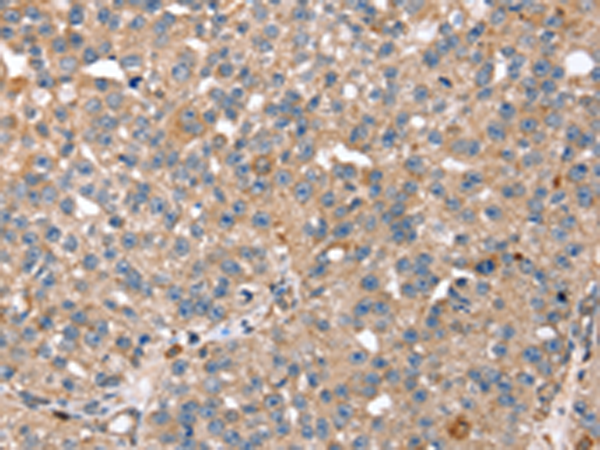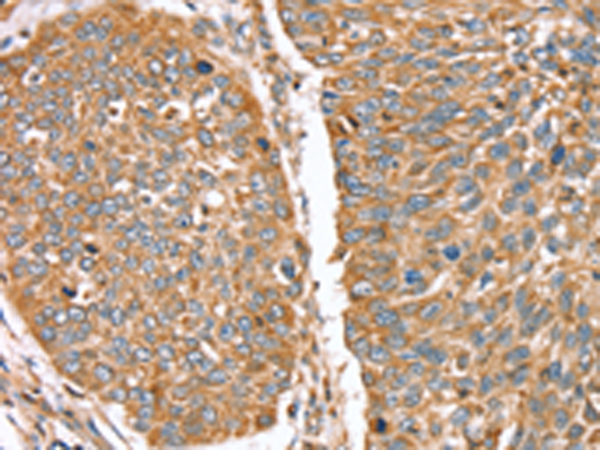

| WB | 咨询技术 | Human,Mouse,Rat |
| IF | 咨询技术 | Human,Mouse,Rat |
| IHC | 1/25-1/100 | Human,Mouse,Rat |
| ICC | 技术咨询 | Human,Mouse,Rat |
| FCM | 咨询技术 | Human,Mouse,Rat |
| Elisa | 1/2000-1/5000 | Human,Mouse,Rat |
| Aliases | CGI-123; SID1669 |
| Host/Isotype | Rabbit IgG |
| Antibody Type | Primary antibody |
| Storage | Store at 4°C short term. Aliquot and store at -20°C long term. Avoid freeze/thaw cycles. |
| Species Reactivity | Human, Mouse |
| Immunogen | Fusion protein of human RNF11 |
| Formulation | Purified antibody in PBS with 0.05% sodium azide and 50% glycerol. |
+ +
以下是关于RNF11抗体的3篇参考文献的简要信息:
1. **文献名称**:*RNF11 modulates proteasomal degradation and ubiquitination of EGFR in cancer cells*
**作者**:Colland F. et al.
**摘要**:该研究通过Western blot和免疫沉淀技术,利用RNF11抗体揭示了RNF11在调控表皮生长因子受体(EGFR)泛素化及蛋白酶体降解中的作用,发现其过表达可抑制肿瘤细胞增殖。
2. **文献名称**:*RNF11 is a negative regulator of NF-κB signaling by targeting TRAF6 ubiquitination*
**作者**:Li Y. et al.
**摘要**:研究利用RNF11特异性抗体进行免疫荧光和共聚焦显微镜分析,证明RNF11通过抑制TRAF6泛素化负调控NF-κB通路,影响炎症反应及细胞存活。
3. **文献名称**:*Dysregulation of RNF11 in Alzheimer’s disease: Implications for amyloid-β production*
**作者**:Wang H. et al.
**摘要**:通过免疫组化检测阿尔茨海默病患者脑组织中的RNF11表达,发现其与β-淀粉样蛋白沉积呈负相关,提示RNF11可能通过调控γ-分泌酶活性影响疾病进程。
以上文献均使用RNF11抗体在蛋白功能、信号通路及疾病机制研究中展开分析,涵盖癌症、炎症和神经退行性疾病领域。若需扩展,可进一步检索近年文献数据库(如PubMed)。
RNF11 (Ring Finger Protein 11) is an E3 ubiquitin ligase adaptor protein involved in regulating ubiquitination-mediated protein degradation, a critical process for cellular homeostasis. It modulates key signaling pathways, including TGF-β, NF-κB, and EGFR, by interacting with E3 ligases like SMURF1/2. NEDD4. and Itch to target substrates for proteasomal or lysosomal degradation. Structurally, RNF11 contains a conserved RING-H2 domain, a PY motif, and a TM domain, enabling its role in trafficking and substrate recognition. Dysregulation of RNF11 is linked to cancer progression, neurodegenerative diseases (e.g., Parkinson’s), and immune disorders, highlighting its dual tumor-suppressive or oncogenic roles depending on cellular context.
RNF11 antibodies are essential tools for studying its expression, localization, and molecular interactions. They are widely used in techniques such as Western blotting, immunoprecipitation, and immunohistochemistry to explore RNF11’s regulatory mechanisms in disease models. For instance, these antibodies help identify RNF11’s role in degrading tumor suppressors (e.g., PML) or oncoproteins, as well as its involvement in inflammatory responses via NF-κB inhibition. Commercial RNF11 antibodies are typically validated for specificity against its unique epitopes, though cross-reactivity with homologous proteins (e.g., RNF12) requires careful controls. Research utilizing these antibodies continues to clarify RNF11’s therapeutic potential as a modulator of protein stability pathways.
×